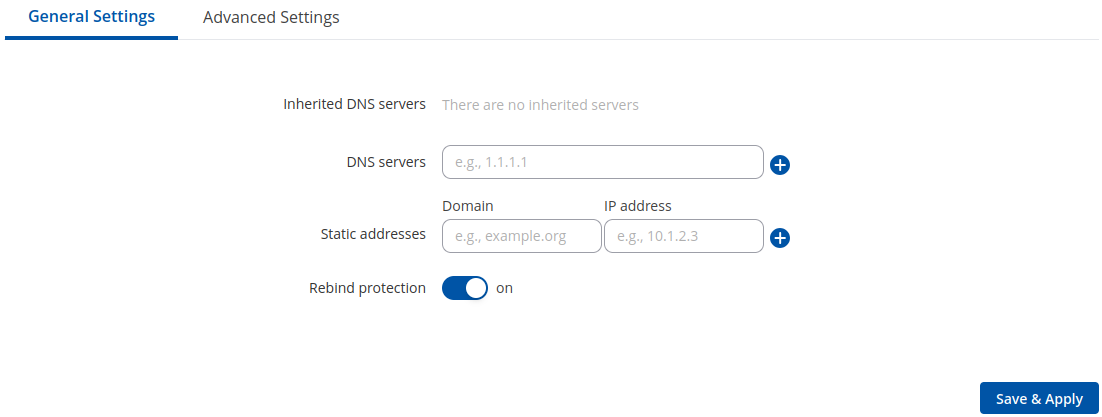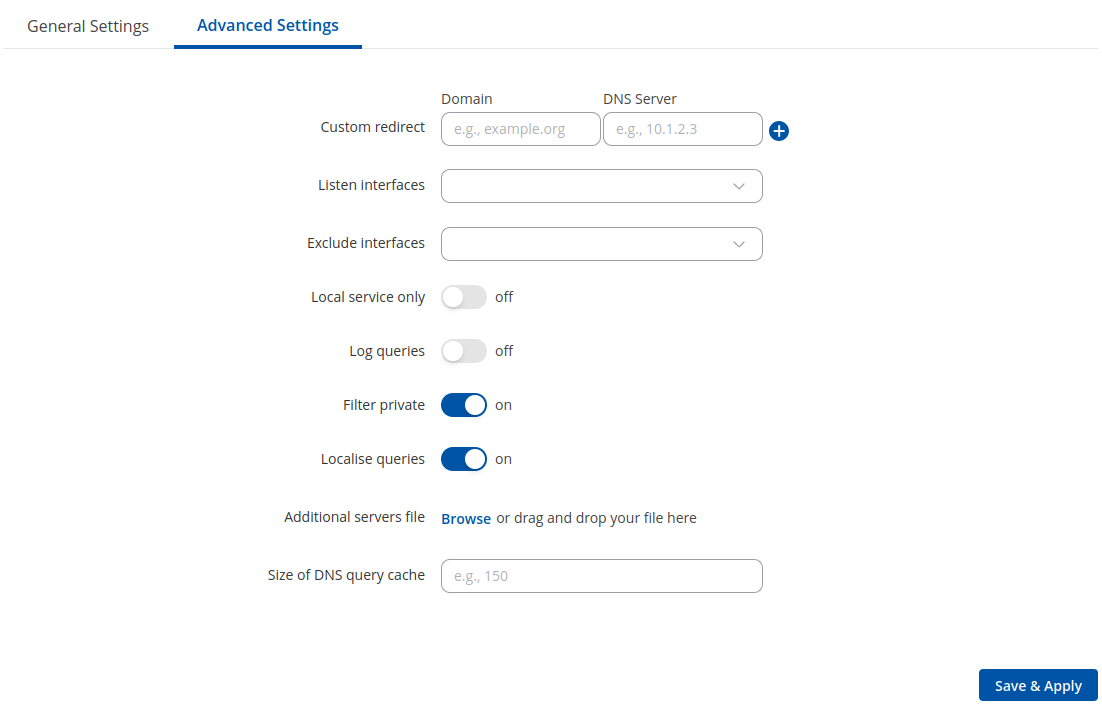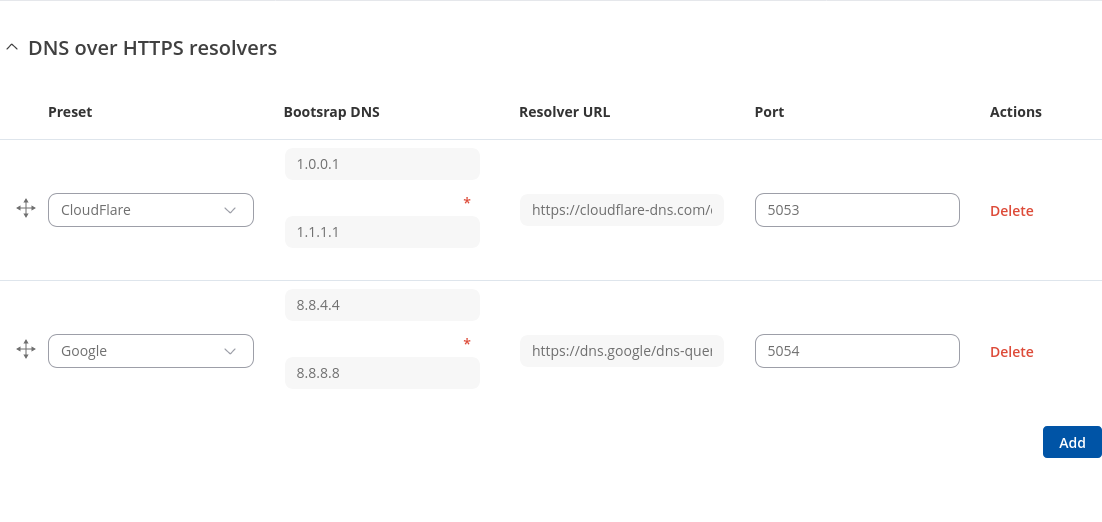Template:Networking rutos manual dns: Difference between revisions
No edit summary |
|||
| (11 intermediate revisions by 3 users not shown) | |||
| Line 1: | Line 1: | ||
{{Template: | {{Template: Networking_device_manual_fw_disclosure | ||
| | | series = {{{series}}} | ||
| series | | name = {{{name}}} | ||
| fw_version ={{Template: Networking_device_manual_latest_fw | |||
| series = {{{series}}} | |||
| name = {{{name}}} | |||
}} | |||
}} | }} | ||
__TOC__ | |||
==Summary== | ==Summary== | ||
| Line 18: | Line 23: | ||
The <b>General Settings</b> section is used to set up the main DNS parameters. Refer to the table below for information on each configuration field. | The <b>General Settings</b> section is used to set up the main DNS parameters. Refer to the table below for information on each configuration field. | ||
[[File: | [[File:Networking_rutos_manual_dns_general_settings_v3.png|border|class=tlt-border]] | ||
<table class="nd-mantable"> | <table class="nd-mantable"> | ||
| Line 27: | Line 32: | ||
</tr> | </tr> | ||
<tr> | <tr> | ||
<td> | <td>Inherited DNS servers</td> | ||
<td> | <td>Inherited server list</td> | ||
<td> | <td>DNS Servers that were inherited from WAN interfaces.</td> | ||
</tr> | </tr> | ||
<tr> | <tr> | ||
<td> | <td>DNS servers</td> | ||
<td> | <td>IP address (ip); default: <b>none</b></td> | ||
<td> | <td>List of DNS servers to forward requests to. See the dnsmasq -S option man page for syntax details. Specify servers to complement inherited ones.</td> | ||
</tr> | </tr> | ||
<tr> | <tr> | ||
<td> | <td>Static addresses</td> | ||
<td>domain name; default: <b> | <td>Hostname (domain name) {{!}} IP address (ip); default: <b>none</b></td> | ||
<td> | <td>List of IP addresses for queried domains. See the dnsmasq -A option man page for syntax details.</td> | ||
</tr> | </tr> | ||
<tr> | <tr> | ||
<td> | <td>Rebind protection</td> | ||
<td>off | <td>off {{!}} on; default: <b>on</b></td> | ||
<td>When enabled, | <td>Discards upstream RFC1918 responses. When enabled, the device will not resolve domain names for internal hosts.</td> | ||
</tr> | </tr> | ||
</table> | |||
===Advanced Settings=== | |||
The <b>Advanced Settings</b> section is used to set up some of the more specific DNS parameters. Refer to the table below for information on each configuration field. | |||
[[File:Networking_rutos_manual_dns_advanced_settings_v3.png|border|class=tlt-border]] | |||
<table class="nd-mantable"> | |||
<tr> | <tr> | ||
< | <th>Field</th> | ||
< | <th>Value</th> | ||
< | <th>Description</th> | ||
</tr> | </tr> | ||
<tr> | <tr> | ||
<td> | <td>Custom redirect</td> | ||
<td> | <td>Hostname (domain name) {{!}} IP address (ip); default: <b>none</b></td> | ||
<td> | <td>Specify server for a domain. This is intended for private nameservers.</td> | ||
</tr> | </tr> | ||
<tr> | <tr> | ||
<td> | <td>Listen Interfaces</td> | ||
<td> | <td>network interface(s); default: <b>none</b></td> | ||
<td> | <td>Limit DHCP and DNS requests listening to these interfaces, and loopback. Leave empty to listen on all interfaces.</td> | ||
</tr> | </tr> | ||
<tr> | <tr> | ||
<td> | <td>Exclude Interfaces</td> | ||
<td> | <td>network interface(s); default: <b>none</b></td> | ||
<td> | <td>Prevent DHCP and DNS requests listening on these interfaces. Leave empty to listen on all interfaces.</td> | ||
</tr> | </tr> | ||
<tr> | <tr> | ||
<td>Local Service Only</td> | <td>Local Service Only</td> | ||
<td>off | <td>off {{!}} on; default: <b>off</b></td> | ||
<td>Limit DNS service to subnets | <td>Limit DNS service to subnets interfaces on which we are serving DNS.</td> | ||
</tr> | </tr> | ||
<tr> | <tr> | ||
<td> | <td>Log queries</td> | ||
<td>off | <td>off {{!}} on; default: <b>off</b></td> | ||
<td> | <td>Write received DNS requests to syslog.</td> | ||
</tr> | |||
<tr> | |||
<td>Filter private</td> | |||
<td>off {{!}} on; default: <b>on</b></td> | |||
<td>Do not forward reverse lookups for local networks.</td> | |||
</tr> | </tr> | ||
<tr> | <tr> | ||
<td> | <td>Localise queries</td> | ||
<td> | <td>off {{!}} on; default: <b>on</b></td> | ||
<td> | <td>Localise hostname depending on the requesting subnet if multiple IPs are available.</td> | ||
</tr> | |||
<tr> | |||
<td>Additional servers file</td> | |||
<td>text file; default: <b>none</b></td> | |||
<td>Uploads an additional DNS servers file. This file may contain lines like 'server=/domain/1.2.3.4' or 'server=1.2.3.4' for domain-specific or full upstream DNS servers.</td> | |||
</tr> | </tr> | ||
<tr> | <tr> | ||
<td> | <td>Size of DNS query cache</td> | ||
<td> | <td>integer [0..10000]; default: <b>none</b></td> | ||
<td> | <td>Number of cached DNS entries (max is 10000, 0 is no caching).</td> | ||
</tr> | </tr> | ||
</table> | </table> | ||
== | ==HTTPS DNS Proxy== | ||
Light-weight DNS-over-HTTPS, non-caching translation proxy for the RFC 8484 DoH standard. It receives regular (UDP) DNS requests and resolves them via DoH resolver. | |||
<b>Note:</b> IGMP Proxy is additional software that can be installed from the <b>System → [[{{{name}}} Package Manager|Package Manager]]</b> page. | |||
===HTTPS DNS proxy configuration=== | |||
[[File: | The <b>HTTPS DNS proxy configuration</b> section is used to enable the service. Refer to the table below for information on each configuration field. | ||
[[File:Networking_rutos_manual_https_dns_proxy.png|border|class=tlt-border]] | |||
<table class="nd-mantable"> | <table class="nd-mantable"> | ||
| Line 109: | Line 131: | ||
</tr> | </tr> | ||
<tr> | <tr> | ||
<td> | <td>Enable</td> | ||
<td>off | <td>off {{!}} on; default: <b>off</b></td> | ||
<td> | <td>Enables HTTPS DNS proxy configuration.</td> | ||
</tr> | </tr> | ||
</table> | </table> | ||
== | ===DNS over HTTPS resolvers=== | ||
[[File: | The <b>DNS over HTTPS resolvers</b> section is used to set up some of the more specific DNS parameters. Refer to the table below for information on each configuration field. | ||
[[File:Networking_rutos_manual_dns_over_https_resolvers.png|border|class=tlt-border]] | |||
<table class="nd-mantable"> | <table class="nd-mantable"> | ||
| Line 143: | Line 151: | ||
</tr> | </tr> | ||
<tr> | <tr> | ||
<td> | <td>Preset</td> | ||
<td> | <td>Custom {{!}} Google {{!}} CloudFlare; default: <b>CloudFlare</b></td> | ||
<td> | <td>Presets for popular DNS over HTTPS resolvers. Use "Custom" to set your resolver.</td> | ||
</tr> | </tr> | ||
<tr> | <tr> | ||
<td> | <td>Bootsrap DNS</td> | ||
<td> | <td>IPv4/IPv6 address; default: <b>depends on the service provider</b></td> | ||
<td> | <td>This DNS is used for the initial "Resolver URL" resolve.</td> | ||
</tr> | </tr> | ||
<tr> | <tr> | ||
<td> | <td>Resolver URL</td> | ||
<td> | <td>url; default: <b>depends on the service provider</b></td> | ||
<td> | <td>Resolver URL.</td> | ||
</tr> | </tr> | ||
<tr> | <tr> | ||
<td> | <td>Port</td> | ||
<td> | <td>integer [1..65535]; default: <b>depends on the service provider</b></td> | ||
<td> | <td>Internal port used for this resolver. Change only if it collides with existing ports on this device.</td> | ||
</tr> | </tr> | ||
<tr> | <tr> | ||
<td> | <td>Actions</td> | ||
<td> | <td>-interactive button; default: <b>Delete</b></td> | ||
<td> | <td>Deletes the preset.</td> | ||
</tr> | </tr> | ||
</table> | </table> | ||
<b>Note:</b> If more than one resolver is specified then the first is used as the main one and others are used as failovers. | |||
[[Category:{{{name}}} Network section]] | [[Category:{{{name}}} Network section]] | ||
Latest revision as of 10:47, 30 August 2024
The information in this page is updated in accordance with firmware version .
Summary
The DNS page is used to to set up how the device utilizes its own and other DNS servers.
This manual page provides an overview of the DNS windows in {{{name}}} devices.
If you're having trouble finding this page or some of the parameters described here on your device's WebUI, you should turn on "Advanced WebUI" mode. You can do that by clicking the "Advanced" button, located at the top of the WebUI.
General Settings
The General Settings section is used to set up the main DNS parameters. Refer to the table below for information on each configuration field.
| Field | Value | Description |
|---|---|---|
| Inherited DNS servers | Inherited server list | DNS Servers that were inherited from WAN interfaces. |
| DNS servers | IP address (ip); default: none | List of DNS servers to forward requests to. See the dnsmasq -S option man page for syntax details. Specify servers to complement inherited ones. |
| Static addresses | Hostname (domain name) | IP address (ip); default: none | List of IP addresses for queried domains. See the dnsmasq -A option man page for syntax details. |
| Rebind protection | off | on; default: on | Discards upstream RFC1918 responses. When enabled, the device will not resolve domain names for internal hosts. |
Advanced Settings
The Advanced Settings section is used to set up some of the more specific DNS parameters. Refer to the table below for information on each configuration field.
| Field | Value | Description |
|---|---|---|
| Custom redirect | Hostname (domain name) | IP address (ip); default: none | Specify server for a domain. This is intended for private nameservers. |
| Listen Interfaces | network interface(s); default: none | Limit DHCP and DNS requests listening to these interfaces, and loopback. Leave empty to listen on all interfaces. |
| Exclude Interfaces | network interface(s); default: none | Prevent DHCP and DNS requests listening on these interfaces. Leave empty to listen on all interfaces. |
| Local Service Only | off | on; default: off | Limit DNS service to subnets interfaces on which we are serving DNS. |
| Log queries | off | on; default: off | Write received DNS requests to syslog. |
| Filter private | off | on; default: on | Do not forward reverse lookups for local networks. |
| Localise queries | off | on; default: on | Localise hostname depending on the requesting subnet if multiple IPs are available. |
| Additional servers file | text file; default: none | Uploads an additional DNS servers file. This file may contain lines like 'server=/domain/1.2.3.4' or 'server=1.2.3.4' for domain-specific or full upstream DNS servers. |
| Size of DNS query cache | integer [0..10000]; default: none | Number of cached DNS entries (max is 10000, 0 is no caching). |
HTTPS DNS Proxy
Light-weight DNS-over-HTTPS, non-caching translation proxy for the RFC 8484 DoH standard. It receives regular (UDP) DNS requests and resolves them via DoH resolver.
Note: IGMP Proxy is additional software that can be installed from the System → [[{{{name}}} Package Manager|Package Manager]] page.
HTTPS DNS proxy configuration
The HTTPS DNS proxy configuration section is used to enable the service. Refer to the table below for information on each configuration field.
| Field | Value | Description |
|---|---|---|
| Enable | off | on; default: off | Enables HTTPS DNS proxy configuration. |
DNS over HTTPS resolvers
The DNS over HTTPS resolvers section is used to set up some of the more specific DNS parameters. Refer to the table below for information on each configuration field.
| Field | Value | Description |
|---|---|---|
| Preset | Custom | Google | CloudFlare; default: CloudFlare | Presets for popular DNS over HTTPS resolvers. Use "Custom" to set your resolver. |
| Bootsrap DNS | IPv4/IPv6 address; default: depends on the service provider | This DNS is used for the initial "Resolver URL" resolve. |
| Resolver URL | url; default: depends on the service provider | Resolver URL. |
| Port | integer [1..65535]; default: depends on the service provider | Internal port used for this resolver. Change only if it collides with existing ports on this device. |
| Actions | -interactive button; default: Delete | Deletes the preset. |
Note: If more than one resolver is specified then the first is used as the main one and others are used as failovers.
[[Category:{{{name}}} Network section]]





